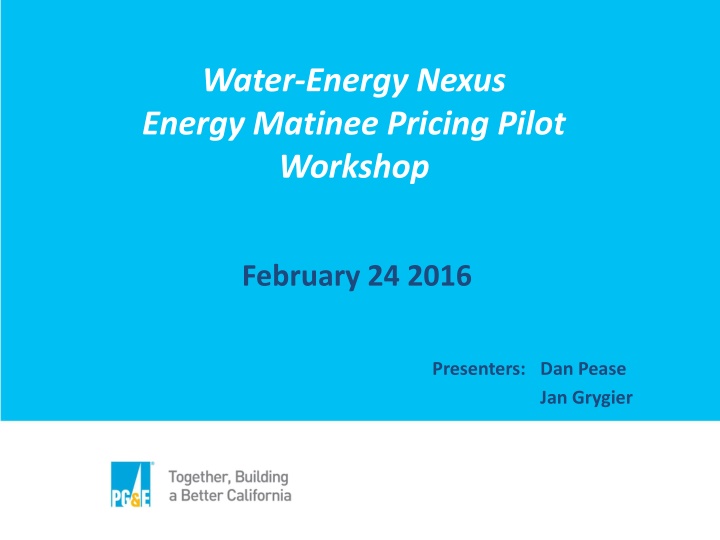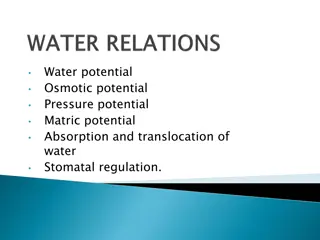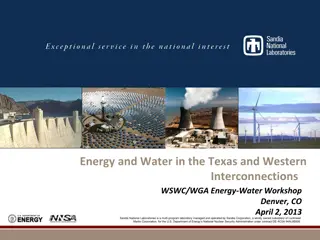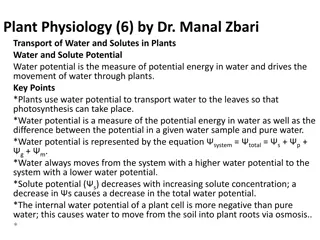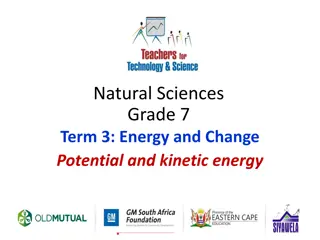Water-Energy Nexus: Pilot Workshop Summary for Potential 2017 Program
The Water-Energy Nexus Pilot Workshop held on February 24, 2016, discussed potential options for the upcoming 2017 program. Some proposed pilot options included leveraging PG&E's Excess Power program, introducing new dynamic and TOU programs, and setting requirements for CPUC decisions on design. A proposed timeline outlined key activities from filing advice letters to system implementation, aiming for program effectiveness by early 2017. The design emphasized running the pilot as if it were in 2020, considering solar and wind generation, negative day-ahead prices, and cost differentials under average hydro conditions over the years 2016-2020.
Download Presentation

Please find below an Image/Link to download the presentation.
The content on the website is provided AS IS for your information and personal use only. It may not be sold, licensed, or shared on other websites without obtaining consent from the author.If you encounter any issues during the download, it is possible that the publisher has removed the file from their server.
You are allowed to download the files provided on this website for personal or commercial use, subject to the condition that they are used lawfully. All files are the property of their respective owners.
The content on the website is provided AS IS for your information and personal use only. It may not be sold, licensed, or shared on other websites without obtaining consent from the author.
E N D
Presentation Transcript
Water-Energy Nexus Energy Matinee Pricing Pilot Workshop February 24 2016 Presenters: Dan Pease Jan Grygier
Overview Options and Recommendation Requirements Schedule Design
Potential 2017 Pilot Options OPTION #1: Leverage PG&E s Excess Power (XSP) pilot approved in D.14-05-025 by modifying billing to broaden the attractiveness of this pilot to customers on schedules with demand charges. OPTION #2: New dynamic program with day-ahead event notification. OPTION #3 (Recommended): New TOU program with preset hours and prices: Incentive to use more during super off-peak hours through bill credits, with revenue-neutral energy price adders in other hours Parallels Residential TOU Pilot Rate #3 Demand in super off-peak hours will not be used to determine demand charges on applicable schedules
Requirements Prompt CPUC decision on design, to allow enough time for implementation Need CPUC guidance soon to inform Advice Letter filing ~March 18 Need Resolution approving Advice Letter by end of May Work must begin in June 2016 to allow for implementation in 2017. Decision on participation levels can help expedite implementation Participation level of 200 accounts or less may allow implementation targeted as early as March 2017. Otherwise implementation would be targeted for June 2017 Cost will be a function Commission requirements as to: Adopted program design Required billing and other systems changes Required Marketing, Education & Outreach Measurement & Evaluation requirements Need approval by June 1 of A.L. establishing a Memorandum Account to record actual implementation costs, with future reasonableness review.
Proposed Timeline Date Activity Comment 2/24/16 Workshop 3/18/16 File Advice Letter with Proposal Memo account and draft tariffs 4/7/16 Advice Letter: Protests due 4/14/16 Advice Letter: Reply due 4/25/16 Advice Letter: Draft Resolution 5/26/16 Final Resolution 6/1/16 Begin Billing and Systems Implementation 7/1/16 11/1/16 Develop Measurement & Evaluation as well as Marketing Education & Outreach Plans By 12/16 File Advice Letter on remaining implementation issues Final tariff, M&E and ME&O Plans As early as March 2017 Program effective (earliest possible date) Dependent on requirements; otherwise could be 6/17
Design - Run Pilot as if it was 2020 2016-2020 Solar and Wind Generation, Number of Hours with Negative Day-Ahead Prices, And Cost Differential during Spring Super Off Peak under Average Hydro Conditions (All Data from 2015 RDW Price Scenarios Model) 2016 2017 2018 2019 2020 GWh Solar + Wind 42,000 45,000 48,000 51,000 54,000 Annual Hours Negative DA Prices 39 81 141 212 310 Percentage Hours Neg. Mar-May 2% 3.5% 6% 8% 11% MGC Cost Differential Winter Off-Peak to Spring HE 10-15 $18/MWh $23/MWh $27/MWh $31/MWh $35/MWh 2020 will likely have approximately 3X more hours with negative prices, and a 50% higher differential between winter off-peak and spring super-off- peak Marginal Generation Costs than 2017. Running pilot using prices and triggers as of 2020 could provide more robust results.
